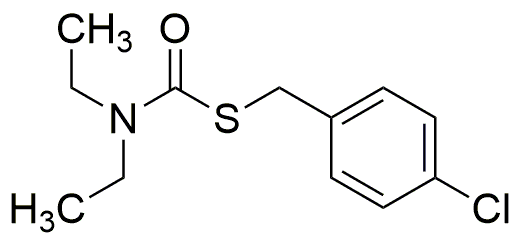Thiabencarb is widely utilized in research focused on:
- Agricultural Pest Control: This chemical is primarily used as a herbicide in rice cultivation, effectively controlling weeds and enhancing crop yield.
- Environmental Studies: Researchers use thiobencarb to study its degradation and behavior in soil and water, helping to assess its environmental impact and safety.
- Analytical Chemistry: It serves as a standard in analytical methods for detecting pesticide residues, ensuring food safety and compliance with regulations.
- Formulation Development: In the agrochemical industry, thiobencarb is used to develop new formulations that improve efficacy and reduce application rates, benefiting both farmers and the environment.
- Resistance Management: It plays a role in integrated pest management strategies, helping to manage herbicide resistance in weed populations, which is crucial for sustainable agriculture.
General Information
Properties
Safety and Regulations
Applications
Thiabencarb is widely utilized in research focused on:
- Agricultural Pest Control: This chemical is primarily used as a herbicide in rice cultivation, effectively controlling weeds and enhancing crop yield.
- Environmental Studies: Researchers use thiobencarb to study its degradation and behavior in soil and water, helping to assess its environmental impact and safety.
- Analytical Chemistry: It serves as a standard in analytical methods for detecting pesticide residues, ensuring food safety and compliance with regulations.
- Formulation Development: In the agrochemical industry, thiobencarb is used to develop new formulations that improve efficacy and reduce application rates, benefiting both farmers and the environment.
- Resistance Management: It plays a role in integrated pest management strategies, helping to manage herbicide resistance in weed populations, which is crucial for sustainable agriculture.
Documents
Safety Data Sheets (SDS)
The SDS provides comprehensive safety information on handling, storage, and disposal of the product.
Product Specification (PS)
The PS provides a comprehensive breakdown of the product’s properties, including chemical composition, physical state, purity, and storage requirements. It also details acceptable quality ranges and the product's intended applications.
Certificates of Analysis (COA)
Search for Certificates of Analysis (COA) by entering the products Lot Number. Lot and Batch Numbers can be found on a product’s label following the words ‘Lot’ or ‘Batch’.
*Catalog Number
*Lot Number
Certificates Of Origin (COO)
This COO confirms the country where the product was manufactured, and also details the materials and components used in it and whether it is derived from natural, synthetic, or other specific sources. This certificate may be required for customs, trade, and regulatory compliance.
*Catalog Number
*Lot Number
Safety Data Sheets (SDS)
The SDS provides comprehensive safety information on handling, storage, and disposal of the product.
DownloadProduct Specification (PS)
The PS provides a comprehensive breakdown of the product’s properties, including chemical composition, physical state, purity, and storage requirements. It also details acceptable quality ranges and the product's intended applications.
DownloadCertificates of Analysis (COA)
Search for Certificates of Analysis (COA) by entering the products Lot Number. Lot and Batch Numbers can be found on a product’s label following the words ‘Lot’ or ‘Batch’.
*Catalog Number
*Lot Number
Certificates Of Origin (COO)
This COO confirms the country where the product was manufactured, and also details the materials and components used in it and whether it is derived from natural, synthetic, or other specific sources. This certificate may be required for customs, trade, and regulatory compliance.


